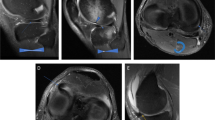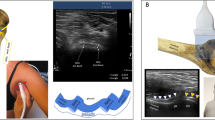Abstract
Background
MR arthrography is an essential diagnostic tool to assess and guide management of labral, ligamentous, fibrocartilaginous, and capsular abnormalities in children. While fluoroscopy is traditionally used for intra-articular contrast administration, ultrasound offers advantages of portability and lack of ionizing radiation exposure for both the patient and proceduralist.
Objective
The purpose of this retrospective study is to quantify technical success and frequency of complications of ultrasound-guided arthrogram injections at our institution.
Materials and methods
This retrospective analysis investigates the results of 217 ultrasound-guided arthrograms of the shoulder, elbow, and hip in patients aged 5–18 years. Successful injection of contrast into the target joint, clinical indication for MR arthrography, and complications were reviewed.
Results
Accurate ultrasound-guided intra-articular administration of contrast into the target joint was successful for 100% of shoulder cases (90/90), 97% of elbow cases (77/79), and 98% of hip cases (47/48). Leak of contrast outside the target joint occurred in 1.4% (3/217) of cases. No major side effects including excessive bleeding, paresthesia, allergic reactions, or infection occurred during or after the procedure. Additionally, no major vessel, nerve, or tendon complications were observed on MR images.
Conclusion
Ultrasound guidance is a reliable, effective, and safe approach to arthrography in children.
Graphical Abstract




Similar content being viewed by others
Data availability
The datasets generated and/or analyzed during the current study are available from the corresponding author on reasonable request.
References
Magee T (2009) 3-T MRI of the shoulder: is MR arthrography necessary? Am J Roentgenol 192:86–92
Peterson JJ, Bancroft LW (2009) History of arthrography. Radiol Clin North Am 47:373–386
Choudur HN, Lou EM (2011) Ultrasound-guided gadolinium joint injections for magnetic resonance arthrography. J Clin Ultrasound 39:6–11
Jernick M, Walker Gallego E, Nuzzo M (2017) Retrospective analysis of the accuracy of ultrasound-guided magnetic resonance arthrogram injections of the hip in the office setting. Orthop J Sports Med 5(12). https://doi.org/10.1177/2325967117743915
Otjen J, Parnell SE, Menashe S, Thapa MM (2015) Ultrasound-guided joint injections for MR arthrography in pediatric patients: how we do it. Pediatr Radiol 45:308–316
Dépelteau H, Bureau NJ, Cardinal E, Aubin B, Brassard P (2004) Arthrography of the shoulder: a simple fluoroscopically guided approach for targeting the rotator cuff interval. AJR Am J Roentgenol 182(2):329–332. https://doi.org/10.2214/ajr.182.2.1820329
Schulte-Altedorneburg G, Gebhard M, Wohlgemuth WA et al (2003) MR arthrography: pharmacology, efficacy and safety in clinical trials. Skeletal Radiol 32:1–12
Shortt CP, Morrison WB, Roberts CC et al (2009) Shoulder, hip, and knee arthrography needle placement using fluoroscopic guidance: practice patterns of musculoskeletal radiologists in North America. Skeletal Radiol 38:377–385
Kuratani K, Tanaka M, Hanai H, Hayashida K (2022) Accuracy of shoulder joint injections with ultrasound guidance: confirmed by magnetic resonance arthrography. World J Orthop 13:259–266
Ali AH, Said HG, Abo elhamd E et al (2021) Shoulder MR arthrography: comparative evaluation of three different contrast injection techniques using an anterior approach. J Magn Reson Imaging 53:481–490
Martínez-Martínez A, García-Espinosa J, Ruiz-Santiago F et al (2016) Comparison of ultrasound and fluoroscopic guidance for injection in CT arthrography and MR arthrography of the hip. Radiología (English Edition) 58:454–459
Rutten MJCM, Collins JMP, Maresch BJ et al (2009) Glenohumeral joint injection: a comparative study of ultrasound and fluoroscopically guided techniques before MR arthrography. Eur Radiol 19:722–730
Ng AWH, Hung EHY, Griffith JF et al (2013) Comparison of ultrasound versus fluorcoscopic guided rotator cuff interval approach for MR arthrography. Clin Imaging 37:548–553
Perdikakis E, Drakonaki E, Maris T, Karantanas A (2013) MR arthrography of the shoulder: tolerance evaluation of four different injection techniques. Skeletal Radiol 42:99–105
Byrd JWT, Potts EA, Allison RK, Jones KS (2014) Ultrasound-guided hip injections: a comparative study with fluoroscopy-guided injections. Arthroscopy - J Arthrosc Related Surg 30:42–46
Chopra A, Grainger AJ, Dube B et al (2018) Comparative reliability and diagnostic performance of conventional 3T magnetic resonance imaging and 1.5T magnetic resonance arthrography for the evaluation of internal derangement of the hip. Eur Radiol 28:963–971
Crespo-Rodríguez AM, De Lucas-Villarrubia JC, Pastrana-Ledesma M et al (2017) The diagnostic performance of non-contrast 3-Tesla magnetic resonance imaging (3-T MRI) versus 1.5-Tesla magnetic resonance arthrography (1.5-T MRA) in femoro-acetabular impingement. Eur J Radiol 88:109–116
Zhang P, Li C, Wang W, Zhang B, Miao W, Liu Y (2022) 3.0 T MRI is more recommended to detect acetabular labral tears than MR Arthrography: an updated meta-analysis of diagnostic accuracy. J Orthop Surg Res 17(1):126
Magee T (2015) Accuracy of 3-T MR arthrography versus conventional 3-T MRI of elbow tendons and ligaments compared with surgery. AJR Am J Roentgenol 204:W70–W75
Major NM, Browne J, Domzalski T et al (2011) Evaluation of the glenoid labrum with 3-T MRI: Is intraarticular contrast necessary? Am J Roentgenol 196:1139–1144
Oh CH, Schweitzer ME, Spettell CM (1999) Internal derangements of the shoulder: decision tree and cost-effectiveness analysis of conventional arthrography, conventional MRI, and MR arthrography. Skeletal Radiol. 28(12):670–678. https://doi.org/10.1007/s002560050572
Souza PM, Aguiar RO, Marchiori E, Bardoe SA (2010) Arthrography of the shoulder: a modified ultrasound guided technique of joint injection at the rotator interval. Eur J Radiol 74(3):e29–e32. https://doi.org/10.1016/j.ejrad.2009.03.020
Patel DN, Nayyar S, Hasan S et al (2012) Comparison of ultrasound-guided versus blind glenohumeral injections: a cadaveric study. J Shoulder Elbow Surg 21:1664–1668
Furtado RNV, Pereira DF, da Luz KR et al (2013) Effectiveness of imaging-guided intra-articular injection: a comparison study between fluoroscopy and ultrasound. Revista Brasileira de Reumatologia (English Edition) 53:476–482
Author information
Authors and Affiliations
Contributions
M.T. and J.P.O. conceptualized, supervised, and supported the study. R.I., S.M., and E.M. collected the data. J.O. performed the statistical analysis and drafted the initial manuscript. H.K. edited the manuscript and mentored J.O. H.K. and A.N. provided the figures. All authors reviewed and approved the final manuscript.
Corresponding author
Ethics declarations
Conflicts of interest
None
Additional information
Publisher's Note
Springer Nature remains neutral with regard to jurisdictional claims in published maps and institutional affiliations.
Supplementary Information
Below is the link to the electronic supplementary material.
Supplementary file1 (MP4 1281 KB)
Supplementary file2 (AVI 672 KB)
Rights and permissions
Springer Nature or its licensor (e.g. a society or other partner) holds exclusive rights to this article under a publishing agreement with the author(s) or other rightsholder(s); author self-archiving of the accepted manuscript version of this article is solely governed by the terms of such publishing agreement and applicable law.
About this article
Cite this article
O’Sullivan, J., Kim, H.H.R., Otjen, J.P. et al. Frequency of technical success of ultrasound-guided arthrogram injections in children. Pediatr Radiol 53, 2380–2385 (2023). https://doi.org/10.1007/s00247-023-05777-5
Received:
Revised:
Accepted:
Published:
Issue Date:
DOI: https://doi.org/10.1007/s00247-023-05777-5




